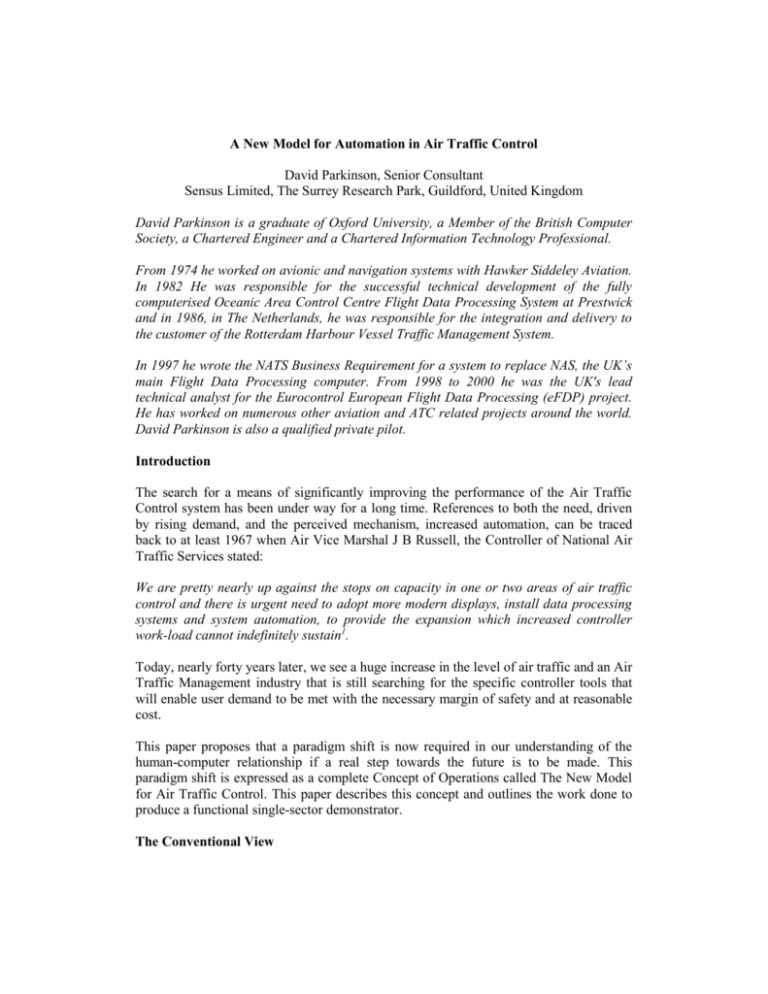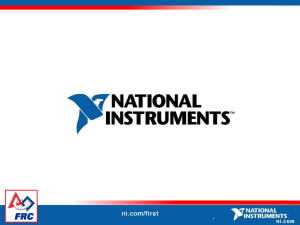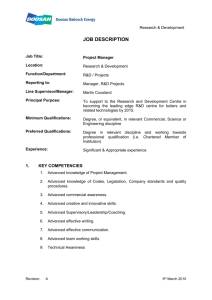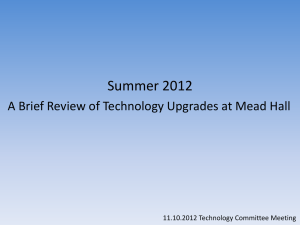David Parkinson is a Natural Science graduate of Oxford University
advertisement

A New Model for Automation in Air Traffic Control David Parkinson, Senior Consultant Sensus Limited, The Surrey Research Park, Guildford, United Kingdom David Parkinson is a graduate of Oxford University, a Member of the British Computer Society, a Chartered Engineer and a Chartered Information Technology Professional. From 1974 he worked on avionic and navigation systems with Hawker Siddeley Aviation. In 1982 He was responsible for the successful technical development of the fully computerised Oceanic Area Control Centre Flight Data Processing System at Prestwick and in 1986, in The Netherlands, he was responsible for the integration and delivery to the customer of the Rotterdam Harbour Vessel Traffic Management System. In 1997 he wrote the NATS Business Requirement for a system to replace NAS, the UK’s main Flight Data Processing computer. From 1998 to 2000 he was the UK's lead technical analyst for the Eurocontrol European Flight Data Processing (eFDP) project. He has worked on numerous other aviation and ATC related projects around the world. David Parkinson is also a qualified private pilot. Introduction The search for a means of significantly improving the performance of the Air Traffic Control system has been under way for a long time. References to both the need, driven by rising demand, and the perceived mechanism, increased automation, can be traced back to at least 1967 when Air Vice Marshal J B Russell, the Controller of National Air Traffic Services stated: We are pretty nearly up against the stops on capacity in one or two areas of air traffic control and there is urgent need to adopt more modern displays, install data processing systems and system automation, to provide the expansion which increased controller work-load cannot indefinitely sustain1. Today, nearly forty years later, we see a huge increase in the level of air traffic and an Air Traffic Management industry that is still searching for the specific controller tools that will enable user demand to be met with the necessary margin of safety and at reasonable cost. This paper proposes that a paradigm shift is now required in our understanding of the human-computer relationship if a real step towards the future is to be made. This paradigm shift is expressed as a complete Concept of Operations called The New Model for Air Traffic Control. This paper describes this concept and outlines the work done to produce a functional single-sector demonstrator. The Conventional View Air Traffic Control is effectively defined by ICAO Document 44442 which states that the major objective of ATC is to provide a service for the prevention of collisions between aircraft while expediting and maintaining an orderly flow of air traffic. Up until now, therefore, much of the focus for controller tools has been on predicting trajectories and locating points in the future where competition for cruising levels or losses of separation may occur. The resulting ‘conflicts’ are then presented to the controller by means of text or graphics and the controller is expected to ‘resolve’ these conflicts in a timely manner by implementing suitable changes to the proposed aircraft flight paths. Sometimes the computer used may also offer suggestions for suitable actions. Proposals for such ‘conflict detection and resolution’ software tools have existed for at least 35 years. However, notwithstanding the development of a number of tools such as URET 3 and FAST4 in the USA and FACTS5 and CORA6 in Europe, Jean-Marc Garot, the Head of Research at Eurocontrol, Brétigny stated in 2001: The core of ATC has remained unaltered since World War II. Advances have been made in information displays and safety nets but not in genuinely revolutionary automated tools7. Why is it so Difficult to Develop Controller Tools? The most significant limitation of the current tools concept is that the controller’s workload is in the first instance increased by having to assimilate additional information or by having to enter data into the system. Also, because the computer is not privy to the intentions of the controller, the computer can have no ‘understanding’ of the solutions the controller intends to implement. The system data used for trajectory prediction will therefore almost always be incomplete or contain inconsistencies. The existence of such inconsistent data then leads to difficulties in building inter-operating systems for adjacent airspaces. The presence of inconsistent or incomplete data can also cause the system to raise false alarms, or fail to provide genuine alarms, for loss of aircraft separation. These difficulties can then affect the construction of the system safety case. These limitations can be overcome to some extent in the steady state but are difficult to manage when traffic levels are high or when unusual events occur. The controller can very easily fall behind with data entry and there is more chance of an unnoticed error than there is with a paper strip and a pen. If the controller depends on the tools to handle high levels of traffic then it is difficult to devise a satisfactory contingency plan for the system failure case. For many tools the user interface is not intuitive and has to be learnt. Many tools are also modal, requiring the controller to select different windows or enter or adjust parameters in the search for a solution. Often the tools will require the selection of a single subject aircraft by the controller giving an asymmetric view of any particular problem. Current toolsets lack coherence and integration. A range of different tools exist to resolve conflicts, to regulate traffic flows, to monitor conformance with a flight plan, to vector aircraft towards a final approach and to schedule departures or sequence arrivals. There is no unified approach. Many of these tools can also produce alerts which may disrupt the controller’s train of thought. Finally, most current tools are passive. They present information to the controller and they respond to inputs from the controller but they do not actively search for any improvements that might be made to the complete set of trajectories under his or her control at any time. The New Model Concept arose from an investigation into whether these difficulties might be overcome by allowing the computer to take a much larger and more pro-active role in the control process. A New Operational Concept In the New Model for Air Traffic Control the computer is used to construct the single best solution to the air traffic situation at any time and offer it to the controller for his or her approval. This solution is presented to the controller in the form of a time ordered list of RT advisory instructions and the controller can accept, modify or ignore each instruction in the list independently. An example of the advisory list from the demonstrator is shown in figure 1. Here, the demonstrator is configured to display only the eight most immediate advisories. The time order is indicated to the controller by the number of seconds before the instruction should be issued. In the example therefore, FLIGHT08 should turn immediately to Midhurst VOR and FLIGHT02 should descend immediately to flight level 80. In 30 seconds time FLIGHT09 is expected on frequency and FLIGHT07 should descend to flight level 70. Each advisory instruction has a button to acknowledge transmission to the aircraft (A) and a modification button (M) for use if the controller wishes to edit the advisory before acceptance. In the New Model concept the primary task of ATC is therefore considered to be the allocation of resources rather than the resolution of conflicts. If the airspace required by any given flight is considered to be a resource and if this airspace is assigned uniquely and correctly to each flight then conflicts between flights will be implicitly avoided. In a conventional system the computer predicts trajectories and identifies conflicts for human resolution; in a New Model system the computer autonomously adjusts all trajectories within its area of responsibility until all conflicts are eliminated. To carry out the calculations the computer takes into account current surveillance information, flight plan data, aircraft performance data, planning controller inputs and any external constraints such as flow restrictions and airfield approach times. The computer recalculates the complete solution at regular intervals and updates the list of advisory instructions. At each update interval the computer re-calculates the complete airspace solution in order to take advantage of any opportunities for trajectory improvement. Figure 1: The RT Advisory Instruction Window from the Demonstrator. Typically, the controller will be able to acknowledge each instruction as it is passed to the aircraft by a single mouse click. Acknowledgement will also cause the Electronic Flight Data (EFD) and the internal flight plan to be updated. In the New Model concept the computer is, in effect, behaving exactly as the controller would, continuously assessing the air situation and developing a suitable plan to handle the traffic. At each update cycle advisories that were accepted will disappear, advisories that were ignored will re-appear if they are still appropriate and advisories that were modified may give rise to new advisories for immediate or later implementation. After each computation cycle, if all of the traffic has moved according to the system’s prediction and the controller has accepted all of the immediate advisories then the advisory list will appear to simply scroll upwards with each advisory becoming one step closer in time. The Controller’s Perspective The New Model approach is flexible and the use of RT phraseology should make it very easy to understand and use. The output can be compared in many ways with that of a human mentor in that the system’s advice is never mandatory and can even be ignored completely. The New Model approach in principle is non-modal. All of the advice is contained in a single window. Because all instructions are included for a flight the New Model approach works with even a single aircraft when no conflicts should be possible. Advisories for turns, climbs and descents not only ensure separation but, if calculated correctly, provide timely advice to achieve the best possible user flight profile. Because the solution to the airspace situation is continuously re-computed, even if the controller ignores the advice and makes no inputs, the system reacts to any actions the controller takes and out-of-date advisories are always discarded. This makes the advisory list in the New Model a true ‘use or ignore’ tool for the controller. When the traffic is light the controller can handle it manually. As the traffic builds up he (or she) can refer to the advisory list for help if necessary. In a full implementation the controller would be at liberty to interrogate any of the trajectories computed by the system if required. However, because the essence of the concept is that the system may change any future trajectory at any time according to changing circumstances in the airspace, such interrogation should not be required very often. A Single Sector Demonstrator Program To investigate the feasibility of the New Model approach, and in particular the difficulty of producing a functional algorithm, a demonstrator has been produced. This models the South West sector of the London Terminal Area where representative traffic levels would be 15 simultaneous aircraft with flow rates of 40 per hour. The airspace covers an area measuring approximately 35nm x 60nm and extends from the base of controlled airspace to a maximum of FL180. The demonstrator together with a comprehensive User Guide can be downloaded from the author’s website8. Production of the demonstrator has shown that it is certainly possible to produce an algorithm to handle traffic in such a sector. Written in Visual Basic for Applications the algorithm takes less than 2 seconds on a 1.9 GHz PC to resolve all active and pending flights over a 25 minute interval. This is long enough to ensure that all currently active flights are resolved to the point of handover to an adjacent sector. The cycle period before complete recalculation of the solution was set to 15 seconds. The demonstrator has been shown informally to a number of controllers and ATC researchers. All have found it easy to use and no fundamental problems have so far been identified with the approach. Discussion of Further Aspects The New Model is not intended to replace the controller. By offering specific traffic advisory information to the controller for verification he (or she) remains very much in the loop and the prime means of ground-air communication for the foreseeable future is still expected to be the voice channel. In a full implementation the controller would also have facilities to set goals and constraints on the resolution process and one of the most common reasons for such intervention would be the need for a flight to deviate due to bad weather. At the end of each computation cycle within the New Model all data in the system is consistent. This permits accurate and automatic updates to any connected Electronic Flight Data displays and continuous automatic co-ordination with adjacent inter-operating sectors. With a suitable description of the airspace environment and modifications to the format of the RT advisory information the New Model concept offers a unified approach to control for radar or procedural operations and is equally applicable to en-route or terminal area environments. The same principles could also be extended to ground movement control at airports. RT phraseology is used in the New Model human-computer interface not only because it is easy to understand but also because a complete series of RT instructions will define a trajectory with implicit margins for variation owing to the performance of individual aircraft. Unfortunately, the reverse is not true; it is difficult to deduce RT instructions from a set of trajectories and the human controller will frequently use additional instructions (such as intermediate climb or descent levels) in order to allow for performance variations and to progress each flight safely. The New Model algorithm will also generate these ‘precautionary’ RT instructions. As it would be possible to operate an ATC simulator employing the New Model concept in a closed loop (all advisories being automatically accepted) the approach lends itself to extensive automatic testing in real or fast time. By supplying live data to a test system the quality of the algorithms could be evaluated and development and deployment timescales considerably reduced. A New Model simulator could also be used in fast time to evaluate proposed new airspace structures. The Trajectory Determination and Conflict Resolution Algorithm In 1971 mathematician Stephen Cook9 coined the term NP-hard for a class of problem that, as the number of variables increases, may become insoluble using any real computer. In the New Model Concept the central algorithm has to create a complete set of conflict-free trajectories for all flights from any starting point. Current work on the New Model aims to demonstrate that the task of such an algorithm in the real world is not an NP-hard problem. This argument is based on the importance of airspace design and the sector structure, the fact that for ATC a workable solution is acceptable (it does not have to be the optimum solution) and the principle that all flights must broadly follow their desired trajectories (it not being acceptable for one flight to be given a significantly greater penalty than any others). The Safety Case The argument for the safety of the New Model concept is based on the use of RT phraseology to define trajectories, the ease with which an inter-operating network could be configured to provide redundancy in the case of system failure and the retention of the human controller in the air-ground loop. It is unlikely that it will be possible to prove the correctness of any algorithm for conflict resolution. However, the use of RT instructions makes it relatively simple for a New Model system to validate the output of its own algorithm by modelling the effects of the instructions in a fast-time simulation. If any problems are identified the aircraft involved can be isolated from the resolution process and dealt with as exceptions. The objective of the New Model concept in both hardware and software terms is that the functionality of the operational system should degrade gracefully rather than collapse completely in the event of any failures. Further Developments The New Model does not require any additional ground or air based equipment in order to function. Its only essential inputs are radar or other surveillance data and access to flight plan information. On first deployment, aircraft separation standards would be the same as those applicable today. In the future it would be possible to implement variable separations calculated according to the probability of collision and based on navigation performance, weather and geometry. Some interactions could be calculated by the New Model and delegated by datalink to pairs of aircraft fitted with ACAS or similar systems. Airspace boundaries in the future might no longer be fixed in time or space so that aircraft could pay for air navigation services according to their use of resources. Non-RVSM aircraft could be allowed to fly through RVSM airspace at quiet times. RNP-10 aircraft could pay more than RNP-5 aircraft to fly at busy times. Operators could be allowed to specify through the flight plan relative priorities between on-time departure, on-time arrival, cruising levels, routeing and lower navigation charges. Additional computers could be employed to improve the quality of trajectories by examining traffic loading across many sectors. Aircraft performance models with encrypted interfaces could be registered by operators so that trajectory prediction might be improved without company confidential operating procedures having to be revealed to ATC authorities. Conclusion The demands on aviation and in particular on ATC have never been more pressing. Fuel costs have risen above 60 US dollars a barrel, environmental concerns demand the most efficient use of fuel and aircraft operators demand more favourable trajectories, fewer delays and lower costs from Air Navigation Service Providers. Soon, the new Very Light Jets might make the problems even more acute. The New Model for Air Traffic Control is a consistent and logical approach to the use of automation in ATC that places the human controller at the key point in the strategic decision making loop. It has the potential to be the basis of a world-wide network that could support Air Traffic Management for the next 50 years. References (1) Electronic Equipment News, May 1967 (2) Rules of the Air and Air Traffic Services ICAO PANS-RAC Doc 4444 (3) Extra Safety Margin Afforded by URET John Sheridan, Aviation International News, September 2002. (4) The Development of the Final Approach Spacing Tool (FAST): A Cooperative Controller-Engineer Design Approach Katharine K. Lee and Thomas J. Davis, NASA Technical Memorandum 110359 August 1995 (5) Future Area Control Tools Support FACTS Peter Whysall, Second USA/EUROPE ATM Seminar, Orlando December 1998. (6) Proposal for Conflict Resolution Assistant (CORA) Seppo Kauppinen, Eurocontrol DED-2, AOR-TF/9/DP-3 28/11/96 (7) Workshop on the Development, Validation & Standardisation of ATM Systems Welcome Address, Jean-Marc Garot, Director Eurocontrol (EEC), 6-7 November 2000. (8) The New Model for Air Traffic Control www.sensus-dp.demon.co.uk (9) The Complexity of Theorem Proving Procedures Stephen Cook, Third Annual ACM Symposium on Theory of Computing, May 1971 Copyright © ATCA 2005. Reproduced by agreement.








